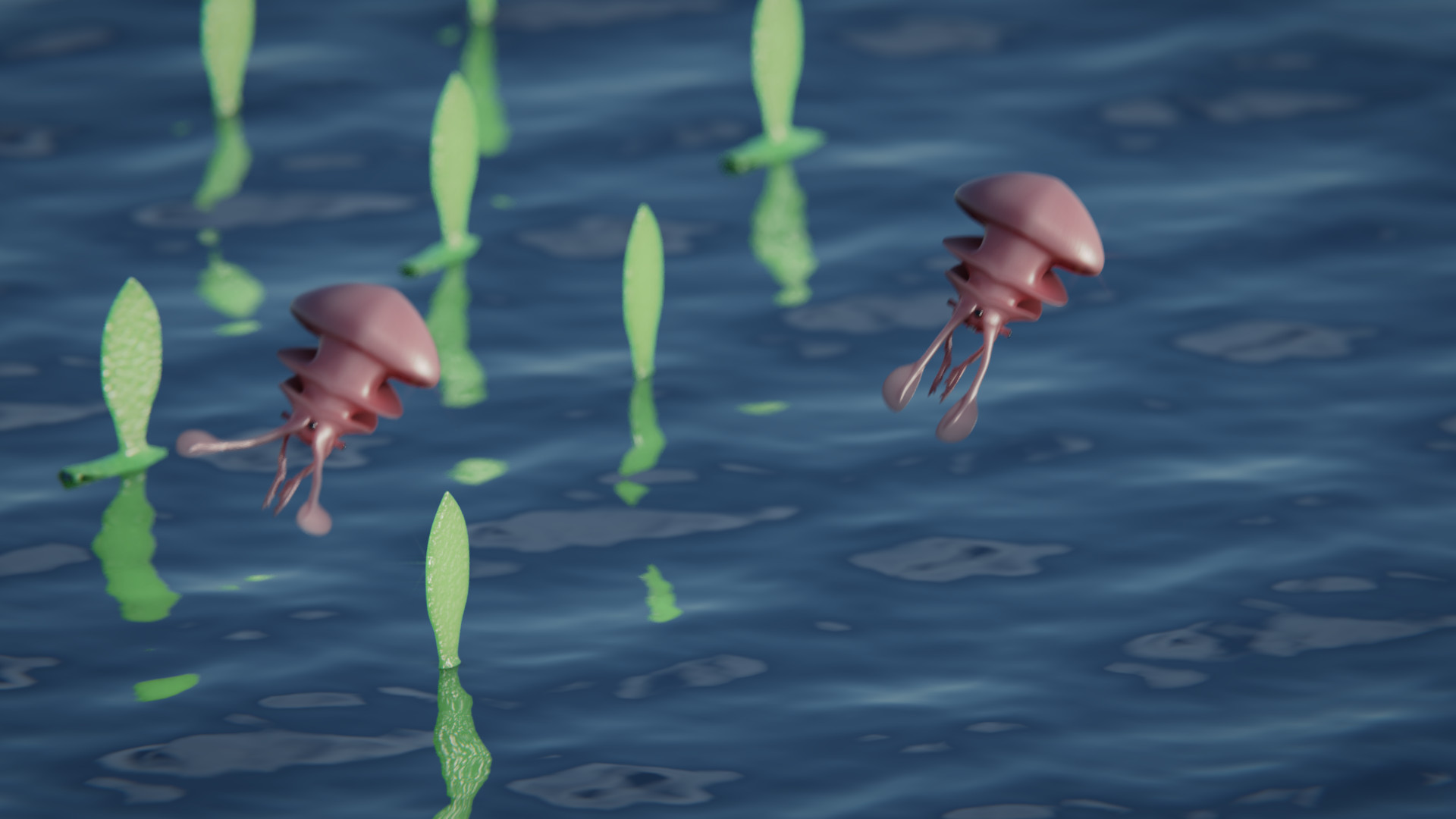Water Hopper
Water Hoppers are descendants of Filter globes. In response to the large scale evolution of predation in the seas of Almaishah, water Hoppers have developed an extremely limited form of flight based on water jet propulsion to escape predators, which they use in a similar manner to flying fish of earth. They launch themselves into the air with their water jets and continue to propel themselves with the jets for a few seconds before running out of water, after which, they can then glide for a few more seconds, with the longest flights lasting up to 10 seconds and carrying them 10-15 meters. They have some limited directional control while mid-air, and are able to make minor targeting adjustment by using there rudder tentacles and fin wings. The water hopper lives in coastal waters, with many species spending much of their time in tidal pools, especially in the early stages of their life cycle. They use their ability for limited flight to hop from pool to pool, when the pool they are in runs out of food, oxygen, or has a predator in it. Thanks to this, they have access to a safe haven from large predators, as well as access to unexploited food resources such as algae and small trapped prey.
Diet wise, water Hoppers are generalist scavengers eating plankton, algae-like single celled retinalphytes, lose food particles, carrion, Phytozoa and small sessile shelled creatures. They do, however, sometimes hunt small free swimming creatures as well. Water Hoppers travel in schools of anywhere from 5 to 50, usually traveling in larger schools when in open waters. Pictured here are two Water Hoppers fleeing underwater danger off the coast of Ras al-Kalb. [Creature Design by Sean O'Donnell]
Basic Information
Anatomy
Water Hoppers vary in size somewhat but are generally no bigger than 20 cm long. The water hopper has its mouth and eyes at its back end in the direction it can travel fastest, so it has had to make some adjustments. The eyes of the water hopper protrude on fleshy mounds to allow it to see past its body, and its two lower most tentacles come forward allowing it to catch prey that it chases, these two tentacles also serve as landing gear and a mean of pulling itself to the nearest pool of water, should it miscalculate a jump and find itself on land. It’s two top most tentacles serve as tail like flippers in the water, and as a directional rudder while in the air, and its remaining 4 tentacles serve as feeding appendages. Its mouth has also developed 4 hard teeth to help it crush small shelled creatures. As predation became more and more prevalent in the seas of Almaishah, evolutionary pressures drove the soft bodied filter globes to become faster and faster to escape their predators. The body flattened out, becoming bilaterally symmetrical for added hydrodynamics. The musculature of the water jets increased, and the main airs sacks connected to the water jets, this mixture of water and air allowed the organism to create a bubble screen when using the jets under water. This air must be refilled at the surface after use. For more constant, long distance swimming, as well as for steering, the rings around the abdomen lost their air and developed muscles to allow them to be used as simple fins, and the sides of the bubble sack flattened out and developed muscle as well. 4 of the 8 tentacles became powerful paddles. Lastly some cartilaginous supports devolved in the fins and air sack. This early Water hopper already spent much of its time near the surface, both so it could refill its air sack, and so it could hunt its planktonic prey, which also mostly dwelt at the surface. And so, when being attacked from below, it was inevitable that some water Hoppers would jump out of the water in an attempt to escape, and thus natural selection kicked in, choosing whoever could stay out of the water longest.
Genetics and Reproduction
Their reproduction cycle remains mostly unchanged from the ancestral filter globe, though they now spawn in tidal pools where their offspring will be safe from most predation. Like their ancestors, the offspring’s jet muscles are underdeveloped, and thus they are stuck in a pool when the tide goes out. This leads to fierce competition between siblings, and of the hundred or so offspring a mating pare might produce, many will starve and become food for their brothers and sisters, if they aren’t eaten by adult water Hoppers first. Ones their jets develop after around 30 local days; they will venture out in open waters, though they will frequently return to the pools as adults to hunt and breed.
EXTINCT
Genetic Ancestor(s)
Genetic Descendants
Scientific Name
Stagnum hopper
Origin/Ancestry
Xenoradiata
Average Length
20 cm
Geographic Distribution
Remove these ads. Join the Worldbuilders Guild











Comments